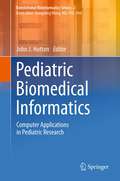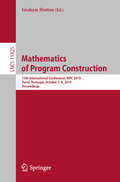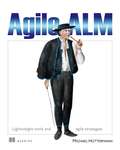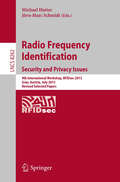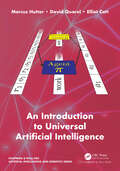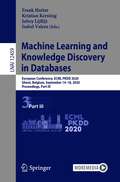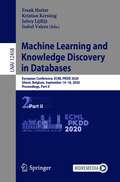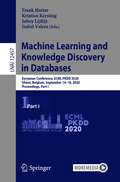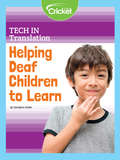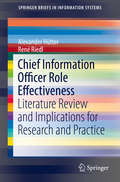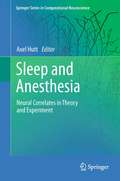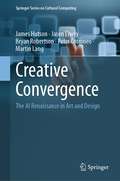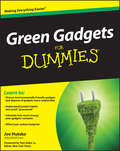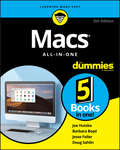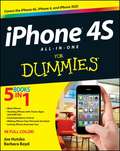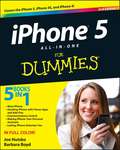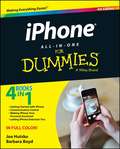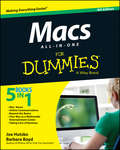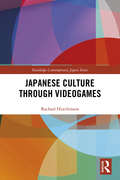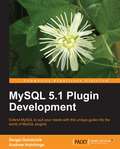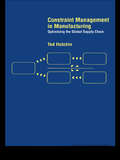- Table View
- List View
Pediatric Biomedical Informatics
by John J. HuttonAdvances in the biomedical sciences, especially genomics, proteomics, and metabolomics, taken together with the expanding use of electronic health records, are radically changing the IT infrastructure and software applications needed to support the transfer of knowledge from bench to bedside. Pediatric Biomedical Informatics: Computer Applications in Pediatric Research describes the core resources in informatics necessary to support biomedical research programs and how these can best be integrated with hospital systems to receive clinical information that is necessary to conduct translational research.The focus is on the authors' recent practical experiences in establishing an informatics infrastructure in a large research-intensive children's hospital. This book is intended for translational researchers and informaticians in pediatrics, but can also serve as a guide to all institutions facing the challenges of developing and strengthening informatics support for biomedical research. The first section of the book discusses important technical challenges underlying computer-based pediatric research, while subsequent sections discuss informatics applications that support biobanking and a broad range of research programs. Pediatric Biomedical Informatics provides practical insights into the design, implementation, and utilization of informatics infrastructures to optimize care and research to benefit children. Dr. John Hutton is the Vice President and Director of Biomedical Informatics at Cincinnati Children's Hospital Medical Center, Cincinnati, OH, USA. He is also Professor of Pediatrics and Associate Dean for Information Services at the University of Cincinnati College of Medicine.
Mathematics of Program Construction: 13th International Conference, MPC 2019, Porto, Portugal, October 7–9, 2019, Proceedings (Lecture Notes in Computer Science #11825)
by Graham HuttonThis book constitutes the refereed proceedings of the 13th International Conference on Mathematics of Program Construction, MPC 2019, held in Porto, Portugal, in October 2019. The 15 revised full papers presented together with an invited paper were carefully reviewed and selected from 22 submissions. The papers deal with mathematical principles and techniques for constructing computer programs. They range from algorithmics to support for program construction in programming languages and systems. Some typical areas are type systems, program analysis and transformation, programming-language semantics, security, and program logics.
Programming in Haskell
by Graham HuttonHaskell is a purely functional language that allows programmers to rapidly develop clear, concise, and correct software. The language has grown in popularity in recent years, both in teaching and in industry. This book is based on the author's experience of teaching Haskell for more than twenty years. All concepts are explained from first principles and no programming experience is required, making this book accessible to a broad spectrum of readers. While Part I focuses on basic concepts, Part II introduces the reader to more advanced topics. This new edition has been extensively updated and expanded to include recent and more advanced features of Haskell, new examples and exercises, selected solutions, and freely downloadable lecture slides and example code. The presentation is clean and simple, while also being fully compliant with the latest version of the language, including recent changes concerning applicative, monadic, foldable, and traversable types. This new edition has been extensively revised and expanded, including four new chapters as well as many new examples and exercises. Fully compliant with the latest version of Haskell, and updated to include more recent features. An accompanying website provides a range of supporting materials, including PowerPoint slides and Haskell code for the extended examples. <P><P><i>Advisory: Bookshare has learned that this book offers only partial accessibility. We have kept it in the collection because it is useful for some of our members. To explore further access options with us, please contact us through the Book Quality link on the right sidebar. Benetech is actively working on projects to improve accessibility issues such as these.</i>
Programming in Haskell
by Graham HuttonHaskell is a purely functional language that allows programmers to rapidly develop clear, concise, and correct software. The language has grown in popularity in recent years, both in teaching and in industry. This book is based on the author's experience of teaching Haskell for more than twenty years. All concepts are explained from first principles and no programming experience is required, making this book accessible to a broad spectrum of readers. While Part I focuses on basic concepts, Part II introduces the reader to more advanced topics. This new edition has been extensively updated and expanded to include recent and more advanced features of Haskell, new examples and exercises, selected solutions, and freely downloadable lecture slides and example code. The presentation is clean and simple, while also being fully compliant with the latest version of the language, including recent changes concerning applicative, monadic, foldable, and traversable types.
Programming in Haskell
by Graham HuttonHaskell is one of the leading languages for teaching functional programming, enabling students to write simpler and cleaner code, and to learn how to structure and reason about programs. This introduction is ideal for beginners: it requires no previous programming experience and all concepts are explained from first principles via carefully chosen examples. Each chapter includes exercises that range from the straightforward to extended projects, plus suggestions for further reading on more advanced topics. The author is a leading Haskell researcher and instructor, well-known for his teaching skills. The presentation is clear and simple, and benefits from having been refined and class-tested over several years. The result is a text that can be used with courses, or for self-learning. Features include: freely accessible powerpoint slides for each chapter; solutions to exercises, and examination questions (with solutions) available to instructors; downloadable code that's fully compliant with the latest Haskell release.
Agile ALM: Lightweight tools and Agile strategies
by Michael HüttermannSummaryAgile ALM is a guide for Java developers who want to integrate flexible agile practices and lightweight tooling along all phases of the software development process. The book introduces a new vision for managing change in requirements and process more efficiently and flexibly. It synthesizes technical and functional elements to provide a comprehensive approach to software development.About the TechnologyAgile Application Lifecycle Management (Agile ALM) combines flexible processes with lightweight tools in a comprehensive and practical approach to building, testing, integrating, and deploying software. Taking an agile approach to ALM improves product quality, reduces time to market, and makes for happier developers.About the BookAgile ALM is a guide for Java developers, testers, and release engineers. By following dozens of experience-driven examples, you'll learn to see the whole application lifecycle as a set of defined tasks, and then master the tools and practices you need to accomplish those tasks effectively. The book introduces state-of-the-art, lightweight tools that can radically improve the speed and fluidity of development and shows you how to integrate them into your processes.The tools and examples are Java-based, but the Agile ALM principles apply to all development platforms. Purchase of the print book comes with an offer of a free PDF, ePub, and Kindle eBook from Manning. Also available is all code from the book. What's InsideA thorough introduction to Agile ALMBuild an integrated Java-based Agile ALM toolchainUse Scrum for release managementReviewed by a team of 20 Agile ALM experts================================Table of ContentsPART 1 INTRODUCTION TO AGILE ALMGetting started with Agile ALMALM and Agile strategiesPART 2 FUNCTIONAL AGILE ALMUsing Scrum for release managementTask-based developmentPART 3 INTEGRATION AND RELEASE MANAGEMENTIntegration and release managementCreating a productive development environmentAdvanced CI tools and recipesPART 4 OUTSIDE-IN AND BARRIER-FREE DEVELOPMENTRequirements and test managementCollaborative and barrier-free development with Groovy and Scala
Radio Frequency Identification
by Michael Hutter Jörn-Marc SchmidtThis book constitutes the proceedings of the 9th Workshop on RFID Security and Privacy, RFIDsec 2013, held in Graz, Austria, in July 2013. The 11 papers presented in this volume were carefully reviewed and selected from 23 submissions. RFIDsec deals with topics of importance to improving the security and privacy of RFID, NFC, contactless technologies, and the Internet of Things. RFIDsec bridges the gap between cryptographic researchers and RFID developers.
An Introduction to Universal Artificial Intelligence (Chapman & Hall/CRC Artificial Intelligence and Robotics Series)
by Marcus Hutter David Quarel Elliot CattAn Introduction to Universal Artificial Intelligence provides the formal underpinning of what it means for an agent to act intelligently in an unknown environment. First presented in Universal Algorithmic Intelligence (Hutter, 2000), UAI offers a framework in which virtually all AI problems can be formulated, and a theory of how to solve them. UAI unifies ideas from sequential decision theory, Bayesian inference, and algorithmic information theory to construct AIXI, an optimal reinforcement learning agent that learns to act optimally in unknown environments. AIXI is the theoretical gold standard for intelligent behavior.The book covers both the theoretical and practical aspects of UAI. Bayesian updating can be done efficiently with context tree weighting, and planning can be approximated by sampling with Monte Carlo tree search. It provides algorithms for the reader to implement, and experimental results to compare against. These algorithms are used to approximate AIXI. The book ends with a philosophical discussion of Artificial General Intelligence: Can super-intelligent agents even be constructed? Is it inevitable that they will be constructed, and what are the potential consequences?This text is suitable for late undergraduate students. It provides an extensive chapter to fill in the required mathematics, probability, information, and computability theory background.
Machine Learning and Knowledge Discovery in Databases: European Conference, ECML PKDD 2020, Ghent, Belgium, September 14–18, 2020, Proceedings, Part III (Lecture Notes in Computer Science #12459)
by Frank Hutter Kristian Kersting Jefrey Lijffijt Isabel ValeraThe 5-volume proceedings, LNAI 12457 until 12461 constitutes the refereed proceedings of the European Conference on Machine Learning and Knowledge Discovery in Databases, ECML PKDD 2020, which was held during September 14-18, 2020. The conference was planned to take place in Ghent, Belgium, but had to change to an online format due to the COVID-19 pandemic.The 232 full papers and 10 demo papers presented in this volume were carefully reviewed and selected for inclusion in the proceedings. The volumes are organized in topical sections as follows: Part I: Pattern Mining; clustering; privacy and fairness; (social) network analysis and computational social science; dimensionality reduction and autoencoders; domain adaptation; sketching, sampling, and binary projections; graphical models and causality; (spatio-) temporal data and recurrent neural networks; collaborative filtering and matrix completion. Part II: deep learning optimization and theory; active learning; adversarial learning; federated learning; Kernel methods and online learning; partial label learning; reinforcement learning; transfer and multi-task learning; Bayesian optimization and few-shot learning. Part III: Combinatorial optimization; large-scale optimization and differential privacy; boosting and ensemble methods; Bayesian methods; architecture of neural networks; graph neural networks; Gaussian processes; computer vision and image processing; natural language processing; bioinformatics. Part IV: applied data science: recommendation; applied data science: anomaly detection; applied data science: Web mining; applied data science: transportation; applied data science: activity recognition; applied data science: hardware and manufacturing; applied data science: spatiotemporal data. Part V: applied data science: social good; applied data science: healthcare; applied data science: e-commerce and finance; applied data science: computational social science; applied data science: sports; demo track.
Machine Learning and Knowledge Discovery in Databases: European Conference, ECML PKDD 2020, Ghent, Belgium, September 14–18, 2020, Proceedings, Part II (Lecture Notes in Computer Science #12458)
by Frank Hutter Kristian Kersting Jefrey Lijffijt Isabel ValeraThe 5-volume proceedings, LNAI 12457 until 12461 constitutes the refereed proceedings of the European Conference on Machine Learning and Knowledge Discovery in Databases, ECML PKDD 2020, which was held during September 14-18, 2020. The conference was planned to take place in Ghent, Belgium, but had to change to an online format due to the COVID-19 pandemic.The 232 full papers and 10 demo papers presented in this volume were carefully reviewed and selected for inclusion in the proceedings. The volumes are organized in topical sections as follows: Part I: Pattern Mining; clustering; privacy and fairness; (social) network analysis and computational social science; dimensionality reduction and autoencoders; domain adaptation; sketching, sampling, and binary projections; graphical models and causality; (spatio-) temporal data and recurrent neural networks; collaborative filtering and matrix completion. Part II: deep learning optimization and theory; active learning; adversarial learning; federated learning; Kernel methods and online learning; partial label learning; reinforcement learning; transfer and multi-task learning; Bayesian optimization and few-shot learning. Part III: Combinatorial optimization; large-scale optimization and differential privacy; boosting and ensemble methods; Bayesian methods; architecture of neural networks; graph neural networks; Gaussian processes; computer vision and image processing; natural language processing; bioinformatics. Part IV: applied data science: recommendation; applied data science: anomaly detection; applied data science: Web mining; applied data science: transportation; applied data science: activity recognition; applied data science: hardware and manufacturing; applied data science: spatiotemporal data. Part V: applied data science: social good; applied data science: healthcare; applied data science: e-commerce and finance; applied data science: computational social science; applied data science: sports; demo track.
Machine Learning and Knowledge Discovery in Databases: European Conference, ECML PKDD 2020, Ghent, Belgium, September 14–18, 2020, Proceedings, Part I (Lecture Notes in Computer Science #12457)
by Frank Hutter Kristian Kersting Jefrey Lijffijt Isabel ValeraThe 5-volume proceedings, LNAI 12457 until 12461 constitutes the refereed proceedings of the European Conference on Machine Learning and Knowledge Discovery in Databases, ECML PKDD 2020, which was held during September 14-18, 2020. The conference was planned to take place in Ghent, Belgium, but had to change to an online format due to the COVID-19 pandemic.The 232 full papers and 10 demo papers presented in this volume were carefully reviewed and selected for inclusion in the proceedings. The volumes are organized in topical sections as follows: Part I: Pattern Mining; clustering; privacy and fairness; (social) network analysis and computational social science; dimensionality reduction and autoencoders; domain adaptation; sketching, sampling, and binary projections; graphical models and causality; (spatio-) temporal data and recurrent neural networks; collaborative filtering and matrix completion. Part II: deep learning optimization and theory; active learning; adversarial learning; federated learning; Kernel methods and online learning; partial label learning; reinforcement learning; transfer and multi-task learning; Bayesian optimization and few-shot learning. Part III: Combinatorial optimization; large-scale optimization and differential privacy; boosting and ensemble methods; Bayesian methods; architecture of neural networks; graph neural networks; Gaussian processes; computer vision and image processing; natural language processing; bioinformatics. Part IV: applied data science: recommendation; applied data science: anomaly detection; applied data science: Web mining; applied data science: transportation; applied data science: activity recognition; applied data science: hardware and manufacturing; applied data science: spatiotemporal data. Part V: applied data science: social good; applied data science: healthcare; applied data science: e-commerce and finance; applied data science: computational social science; applied data science: sports; demo track.
Tech in Translation
by Carollyne HutterIn Morocco, deaf children were at a disadvantage when it comes to their education. When Dr. Abdelhadi Soudi built a computer program that can translate sign language, it improved the way Morocco teaches their deaf children by leaps and bounds!
Chief Information Officer Role Effectiveness
by Alexander Hütter René RiedlThis book reviews latest research on the effectiveness of the chief information officer (CIO) in organizations and its impact on IT success. It presents a model of six different roles, in which a contemporary CIO can act: technology provider, strategic supporter, business thinker, innovation driver, integration advisor, and relationship manager. The book analyses the effectiveness of the CIO role based on four antecedents: CIO personal competence, CIO hierarchical position, the management environment, and the IT infrastructure of the organization in which the CIO operates. Altogether the literature review synthesizes the results of highly fragmented work related to CIO role effectiveness reported in 98 studies published during the past three decades. The book contributes to information systems literature by integrating what is known about the scope and responsibilities of CIO organizational roles in the present management context, and by guiding research and practice in revealing how and why CIOs can achieve effectiveness in the six roles. The book concludes with a discussion of the limitations of the study and potential avenues for future research.
Sleep and Anesthesia
by Axel HuttSleep and anesthesia resemble in many ways at a first glance. The most prominent common feature of course is the loss of consciousness, i.e. the loss of awareness of external stimuli. However a closer look at the loss of consciousness reveals already a difference between sleep and anesthesia: anesthesia is induced by an anesthetic drug whereas we may fall asleep without external cause. Other questions may arise about the difference of the two effects: do we dream during surgery under anesthesia, do we feel pain during sleep? Essentially, we may ask: what is common and what are the differences between sleep and anesthesia? To answer these questions, we may take a look at the neural origin of both effects and the involved physiological pathways. In which way do they resemble? Moreover, we ask what are the detailed features of normal sleep and general anesthesia as applied during surgery and which features exist in both phenomena? If yes in which way? To receive answers to these questions, it is necessary to consider several experimental techniques that reveal underlying neural mechanisms of sleep and anesthesia. Moreover, theoretical models of neural activity may model both phenomena and comes up with predictions or even theories on the underlying mechanisms. Such models may attack several different description levels, from the microscopic level of single neurons to the macroscopic level of neural populations. Such models may give deeper insight into the phenomena if their assumptions are based on experimental findings and their predictions can be compared to experimental results. This comparison step is essential for valuable theoretical models. The book is motivated by two successful workshops on anesthesia and sleep organized during the Computational Neuroscience Conferences in Toronto in 2007 and in Berlin 2009. It aims to cover all the previous aspects with a focus on the link to experimental findings. It elucidates important issues in theoretical models that at the same time reflect some current major research interests. Moreover it considers some diverse issues which are very important to get an overview of the fields. For instance, the book discusses not only neural activity in the brain but also the effects of general anesthesia on the cardio-vascular system and the spinal cord in the context of analgesia. In addition, it considers different experimental techniques on various spatial scales, such as fMRI and EEG-experiments on the macroscopic scale and single neuron and LFP-measurements on the microscopic scale. In total all book chapters reveal aspects of the neural correlates of sleep and anesthesia motivated by experimental data. This focus on the neural mechanism in the light of experimental data is the common feature of the topics and the chapters. In addition, the book aims to clarify the shared physiological mechanisms of both phenomena, but also reveal their physiological differences.
Creative Convergence: The AI Renaissance in Art and Design (Springer Series on Cultural Computing)
by James Hutson Jason Lively Bryan Robertson Peter Cotroneo Martin LangEmbark on a journey that transcends the boundaries of art and technology in the groundbreaking realm of Creative Convergence: The AI Renaissance in Art and Design. This isn't just another book on art and technology- it's a journey that sparks curiosity, fuels innovation, and challenges traditional artistic boundaries. Discover the power of generative Artificial Intelligence (AI) as it melds with human expression, propelling artistry into uncharted territories and redefining traditional notions of both originality and creativity. The text is not just about art or AI; it is about the fusion of both, catalyzing a creative revolution that challenges previous assumptions about human-machine collaboration and how ideation, conceptualization, process and execution are radically rethought. Have you ever wondered how/will AI revolutionize training, education and execution in art and design? Delve into this captivating treatment that contextualizes the disruptions we are experiencing today in the technological innovations and artistic responses and integrations of the past five hundred years. Human creativity has always struggled against technological advance, but ultimately integrated and redefined what "art" is in each era. As such, you will see how AI can be incorporated in various artistic disciplines in this study. Explore real-world case studies that showcase AI's practical impact on 3D design, drawing, digital art, and even web design. The book also addresses the controversial question: Can AI be a co-creator in the creative and artistic process, even assisting in creating an original, signature style? Brace yourself for revelations that will challenge your perceptions of traditional artistry.
Green Gadgets For Dummies
by Joe Hutsko Tom Zeller Jr.Save some green by going green with these environmentally friendly gadgets!With concern for the future of our environment growing stronger and more serious every day, there has never been a better time to take a new approach to some of the most popular gizmos and gadgets on the market and learn how you can convernt to electronics that have minimal environmental impact.Green gadgets encompass everything from iPods to energy-efficient home entertainment devices to solar laptop chargers and crank-powered gizmos. This helpful resource explains how to research green gadgets, make a smart purchasing decision, use products you already own in a more environmentally friendly way, and say goodbye to electronics that zap both energy and money.Explore the environmental and financial benefits of green gadgets with this friendly referenceDiscusses which gadgets save energy-and which ones create energyLearn ways to offset your carbon footprint when you can't reduce consumptionGet tips for understanding products labels and avoiding "greenwash"Discover how to calculate the energy and money your gadgets consumeGet moving and start living green with this informative guide to environmentally and wallet-friendly gadgets!Note: CD-ROM/DVD and other supplementary materials are not included as part of eBook file.
Macs All-In-One For Dummies
by Joe Hutsko Barbara Boyd Jesse Feiler Doug SahlinYour all-in-one guide to the wonderful world of your Mac Are you getting the most from your Mac? Given what’s possible, it’s pretty unlikely. Whether you’re just beginning your journey or are already a seasoned traveler, the six information-packed minibooks included in Macs All-in-One for Dummies open up a world of knowledge, from how to set up a recently bought Mac to exploring the coolest new features on your beloved device. Now updated with what you need to know about the newest generation of hardware and software, Macs All-in-One For Dummies is your guide to simply everything: protecting your Mac; backing up and restoring data with Time Machine; managing applications on the Dock, Launchpad, and Desktop; syncing with iCloud, organizing your life with Calendar, Reminders, Notes, and Notifications; presenting with Keynote; crunching with Numbers; getting creative with iMovie and GarageBand—the list goes on! Explore the newest version of MacOS Set up and customize a new Mac with ease Become more efficient, professional, smart, and creative with the latest must-have apps Use Home Sharing to stream content to other computers, iOS devices, and Apple TVs Dive into six books in one place: Mac Basics, Online Communications, Beyond the Basics, Your Mac as a Multimedia Entertainment Center, Taking Care of Business, and Mac Networking Whatever you want from your world of Mac, you’ll find it here—as well as a million other incredible things you’ll love. Get started on your new Mac journey today!
iPhone 4S All-in-One For Dummies
by Joe Hutsko Barbara BoydGo from smartphone newbie to iPhone rock star with this amazing all-in-one guide!Here's the book for iPhone users who want it all--the basics to get started and the advanced info that puts all the iPhone's power at your fingertips. iPhone All-in-One For Dummies includes five minibooks - more than 600 pages in full color--packed with next-step information for iPhone power users at home, at work, or on the go. Writing in the famous straightforward yet fun For Dummies style, tech experts John Hutsko and Barbara Boyd get you acquainted with your iPhone and take you step by step from simple to advanced: surfing the Web to taking photos and videos; staying in touch via e-mail, video calls, and social media to losing yourself in e-books and magazines to guru-level techniques anyone can learn.Five minibooks include Meet the iPhone, Stocking the iPhone with iTunes Apps and Add-Ons, Communications Central, Making Your iPhone Your Personal Assistant, Letting iPhone Entertain You; each walks you through all aspects of the incredible iPhone's functionalityGets you up to speed with the latest iPhone models plus iOS 5 and all its featuresExplains how to make phone and video calls, exchange e-mails, text and multimedia messages, surf the Web, and buy apps, music, movies, and moreGoes beyond fun to getting work done with pocket-sized office suite and doc apps, contacts and calendars, iBooks and eReadersGives up-to-date info on Facebook, Twitter, Yelp, FourSquare, and other social networksShares insider tips and troubleshooting techniquesYou'll take charge of your iPhone and take your world with you everywhere you go with iPhone All-in-One For Dummies.
iPhone 5 All-in-One For Dummies, 2nd Edition
by Joe Hutsko Barbara BoydOutsmart the smartest smartphone around: the iPhone 5! If you want to rock the hottest smartphone in town, get this great guide and find out how to get the very most out of the incredible iPhone. Five, full-color minibooks cover everything you want to know: iPhone basics, how to load your phone with add-ons and amazing apps, using the Siri Personal Assistant to keep your life on track, letting iPhone entertain you, and much more. It's over 600 pages packed with the latest on the latest, including iOS 6. Find a wealth of great ways to use your iPhone at home, at work, or on the go with this fun and easy guide. Covers the iPhone 5, iPhone 4S, and iPhone 4 Five minibooks: Meet the iPhone, Stocking the iPhone with iTunes Apps and Add-Ons, Communications Central, Making Your iPhone Your Personal Assistant, and Letting iPhone Entertain You, walk you through all aspects of using your iPhone Gets you up to speed with the latest iPhone features and functions including the iOS 6 update Explains how to make phone and FaceTime video calls; exchange e-mails, text and multimedia messages; surf the web; buy apps; shoot and share videos; use Maps to get from Point A to Point B; and much more Shares valuable tips on troubleshooting, syncing your device with iCloud, connecting on the go, and keeping your iPhone happy Whether you're an iPhone newbie or already a savvy smartphone star, you'll find something you can use in iPhone 5 All-in-One For Dummies, 2nd Edition.
iPhone All-in-One For Dummies
by Joe Hutsko Barbara BoydNearly 600 pages of content gets you up and running on your new iPhoneWant to get the most out of your iPhone? You've come to the right place. You'll be up and running in no time with easy coverage of iPhone basics, how to use the built-in iPhone apps, setting up security, texting, and more. And of course, it explains all the fun stuff too, like how to use Siri, your voice-activated personal assistant, video-chat with FaceTime, find your way with the Maps and driving directions, and much more. Whether this is your first iPhone or an upgrade to the latest version, get ready to outsmart the smartest smartphone in town with iPhone All-in-One For Dummies, 3rd Edition.Fully updated to cover the iPhone 5s, iPhone 5c, and iOS 7!Five minibooks walk you through all aspects of using your iPhone: Meet the iPhone, Stocking the iPhone with iTunes Apps and Add-Ons, Communications Central, Making Your iPhone Your Personal Assistant, and Letting iPhone Entertain YouGets you up to speed with the latest iPhone features, including all the new features in the iWork apps for iPhone!Explains how to make phone and FaceTime video calls; exchange e-mails, texts, and multimedia messages; surf the web; find the latest apps, e-books, music, and games; shoot and share videos; sync with iCloud; and much moreHelps you keep your iPhone safe and happy, as well as troubleshoot and fix common problemsFind a wealth of great ways to use your iPhone at home, at work, or on the go with this fun and easy guide.
Macs All-in-One For Dummies
by Joe Hutsko Barbara BoydThe ultimate beginner resource for learning the key features and tools of your MacMacs are easy to use, but this guide helps you take advantage of all the cool features and make the most of your Mac. Fully updated, it covers the newest operating system, as well as the latest versions of iLife and iWork. The featured minibooks introduce you to Mac basics; photos, music, and movies; the Internet; other Mac programs; timesaving tips with a Mac; and Mac networking. Serves as an ideal resource for those switching to a Mac from a PC as well as for Mac users who are upgradingHelps you set up and customize your Mac and get to know the Mac wayExplains how to get online, surf with Safari, and send and receive e-mailCovers working with photos, music, and movies, as well as crunching numbers and creating presentations with iWorkExplores setting up a network, running Windows on a Mac via Bootcamp, and automating your MacProvides troubleshooting tips and advice on protecting your MacMacs All-in-One For Dummies, 3nd Edition gives you the full scoop on using all the cool Mac features.
Logic in Computer Science: Modelling and Reasoning about Systems
by Michael Huth Mark RyanIn recent years, powerful tools for verifying hardware and software systems have been developed. Major companies, such as Intel, Siemens, BT, AT & T, and IBM have increasingly become interested in that technology. Students need a basic formal training that allows them to gain sufficient proficiency in using logic-based verification methods. This book addresses these needs by providing a sound basis in logic and an introduction to the logical frameworks used in modeling, specifying and verifying computer systems. Coverage provides a simple and clear presentation, detailing propositional and predicate logic as well as some specialized logics used for reasoning about the correctness of computer systems. The authors introduce a carefully chosen core of essential terminology; further technicalities are introduced only where they are required by the applications. Numerous examples are given, as well as a full exposition of a fast-growing technique for modeling and verifying computer systems, known as symbolic model checking. It will be an ideal introduction for undergraduate students. A worldwide web tutorial that supports the course activities and provides solutions to the sample exercises is available to instructors.
Japanese Culture Through Videogames (Routledge Contemporary Japan Series)
by Rachael HutchinsonExamining a wide range of Japanese videogames, including arcade fighting games, PC-based strategy games and console JRPGs, this book assesses their cultural significance and shows how gameplay and context can be analyzed together to understand videogames as a dynamic mode of artistic expression. Well-known titles such as Final Fantasy, Metal Gear Solid, Street Fighter and Katamari Damacy are evaluated in detail, showing how ideology and critique are conveyed through game narrative and character design as well as user interface, cabinet art, and peripherals. This book also considers how ‘Japan’ has been packaged for domestic and overseas consumers, and how Japanese designers have used the medium to express ideas about home and nation, nuclear energy, war and historical memory, social breakdown and bioethics. Placing each title in its historical context, Hutchinson ultimately shows that videogames are a relatively recent but significant site where cultural identity is played out in modern Japan. Comparing Japanese videogames with their American counterparts, as well as other media forms, such as film, manga and anime, Japanese Culture Through Videogames will be useful to students and scholars of Japanese culture and society, as well as Game Studies, Media Studies and Japanese Studies more generally.
MySQL 5.1 Plugin Development
by Andrew HutchingsThis book is written in a hands-on style that actively involves you while you read through its chapters. In every chapter you, along with the author, will be implementing one or more fully working example plugins. The process is accompanied with a detailed step-by-step explanation of the code, at the same time providing you with resources to create your own plugins. If you are a MySQL application developer or a programmer who wants to interface with MySQL server, this book is for you. Basic knowledge of C/C++, SQL, and MySQL in particular is assumed in the book, but no deep familiarity with any of the topics is required.
Constraint Management in Manufacturing: Optimising the Supply Chain
by Ted HutchinFocusing on making money out of the supply chain, this book describes how to successfully manage manufacturing companies in today's global context. The text explores how constraint management, with roots in the Theory of Constraints, produces wealth through the development of manufacturers' strengths. Constraint Management in Manufacturing:
